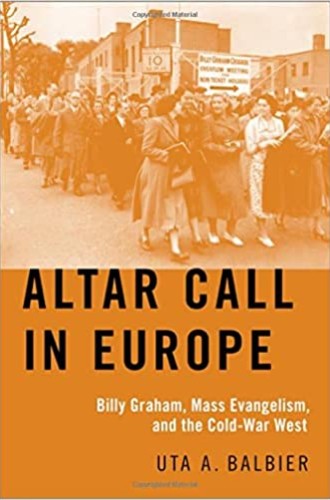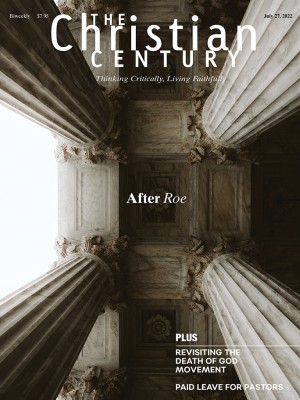Billy Graham’s transatlantic brand
America’s pastor stepped into a historical moment framed by the Cold War and secularization.
Uta A. Balbier’s ambitious book chronicles how evangelist Billy Graham became a transatlantic household name—one recognizable in the capitals of the United States, Britain, and Germany—on his way to becoming a global phenomenon. That journey began before any of Graham’s landmark American crusades. Before his breakout campaign in Los Angeles in 1949, there was his Youth for Christ mission to London in 1946. Before his 1957 New York City crusade, there were Harringay-London and Berlin in 1954, both of which informed how Graham would tackle New York. With this transatlantic focus, Balbier charts how the quintessential American evangelist gained lessons and influence through an international ministry that forged “one evangelical Western community.”
Placing Graham in this international context, Balbier argues, highlights the connections, not the disjuncture, between the revival of Christianity in the United States and in Britain and Germany in the mid-1950s. Across these nations, “Graham stepped into religious landscapes already committed to reform and evangelism” in a historical moment framed by secularization, Cold War anticommunism, rising consumerism, and technological advance. Facing these common forces tied Christians together, and Graham’s “big tent” evangelism formed them into a transatlantic, ecumenical “imagined community.” As Balbier writes, they had become “members of the Billy Graham family.”
Read our latest issue or browse back issues.
The Billy Graham family navigated sacred, secular, and consumer capitalism through a middle-class religious faith and lifestyle epitomized and legitimated by the US evangelist. Food and drink—including the iconic Coca-Cola—satiated physical hunger in preparation for a message that would feed a spiritual one. Corporate sponsorship and endorsement from business leaders furthered the symmetry of a market-based society and Graham’s quip that “we are salesmen of the most important treasure on earth.” The mass campaigns, modern marketing techniques, and use of television and radio mainstreamed this brand of evangelicalism while simultaneously securing the Graham brand across continents. This point is driven home by Balbier’s quotation of Graham’s public relations manager Jerry Beavan, who compared the evangelist to the recognizability of a Cadillac: “Billy is like a Cadillac. We don’t have to explain.”
With few exceptions, Graham’s anticommunism required no explanation either. Spiritual revival promised another line of defense against the atheist Soviet Union and the spread of communism. As Balbier notes, religious strength and national strength were twinned across all three nations, with Graham serving as a conduit for the creation of a “spiritual Free World.” His earlier Washington, DC, crusade, along with his preaching in London’s Trafalgar Square and Berlin’s Olympic Stadium, fused Christianity to national character and Western civilization.
Prayer, Balbier expertly shows, linked the transatlantic revival spiritually. In the minds of the faithful, multinational prayer chains ensured the success of Graham’s campaigns and promised renewal of what they understood to be the Christian destinies of their home countries. Balbier’s images of New Yorkers of all denominational stripes praying for the success of the Harringay crusade and Londoners a few years later raising pleas for the New York campaign of 1957 enrich her account of the transatlantic connections between everyday Christians. Reports of prayer in anticipation of the New York crusade also came from “Basel, Mexico City, Havana, Hong Kong, and Tokyo.”
Buses carried still more expressions of devotion to and from crusade sites as a part of a transportation program developed for Harringay known as Operation Andrew. Thereafter—from Berlin to New York—Operation Andrew bused pilgrims of all types, both churched and unchurched, to hear Graham. These mobile devotional spaces extended the worshipful atmosphere of the main event, with riders singing, committing themselves to Christ, and conversing with Christian counselors on board.
Challenges to Balbier’s argument emerge from her frequent caveats and qualifications about the extent of the religious-cultural parallelism, or lack thereof, between the United States, England, and Germany. The German case never fits comfortably in her account because of a “unique evangelistic and pietist past” and a more complex approach to anticommunism and consumerism. Not only Germany but each of the three nations appears distinct as Balbier closes her analysis of the transatlantic revival landscape in each context. “These significant differences in the religious trajectories from which American, British, and German Christians came to Graham’s revival meetings, as well as the different directions in which they left them, makes an interpretation of the religious similarities and conjunctures that the 1950s crusades brought to light even more important.” It is unclear what deserves more emphasis, the “significant differences” or the “similarities and conjunctures.”
This question of emphasis continues in Balbier’s evaluation of the intersection of capitalism and Graham’s evangelism. She observes, “Yet there was one theme of Graham’s mission that proved hard, if not impossible, to transfer into the European public discourse: the close relationship between business, capitalism, and evangelical Christianity.” She characterizes this divide starkly later in the chapter: “Too deep were the differences in the religious development of the old and the new continent, with a religious market and the Christian gospel of the economic free market existing only on one side of the Atlantic.” A “one side of the Atlantic” story confuses a study attempting to show how “common transnational discourses” existed on the fundamental theme of consumer capitalism.
Balbier judiciously documents these complexities of her argument. But unfortunately, she tries to overcome them with her strained transatlantic “one evangelical Western community” theme. Elsewhere in the book her argument more accurately reflects how Graham’s missions provided a shared experience amid distinct cultural particularities that diverged, sometimes sharply, from the Graham image and message concerning anticommunism, consumerism, and secularization.
That is different from a transatlantic revival, but it’s no less important. Balbier’s achievement is a history of Billy Graham’s international-American evangelical career and the formation of a “Billy Graham family” that sometimes stopped at and sometimes transcended national boundaries and cultures.
* * * * * *
Jon Mathieu, the Christian Century's community engagement editor, discusses this book review and Billy Graham's legacy in Europe with the review's author Andrew Finstuen.






